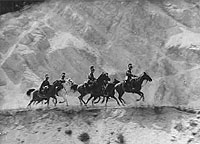 Büntetőexpedició
Büntetőexpedició
Hungary, 1970, black and white, 34 mins.
Is there another national film culture that has devoted so much screen time to the study of horses? Not merely in the sense of lots of them on screen at any one time (there are plenty of American-made Westerns that offer much in that department), but in the way that many sequences in Hungarian films seem to exist solely to present the horse from multiple perspectives, whether in long shot as part of a large group, or individual body parts in extreme close-up. Notionally, Dezső Magyar’s film is set in 1913, and is about a group of soldiers representing the Austro-Hungarian empire establishing order in a Serbian village after colleagues are killed by rebels, but any narrative impetus is quickly buried in a series of lengthy, beautifully-filmed studies of horses in motion, underscored either by a Bach Brandenburg Concerto or simply the noise of their thudding hooves against faint bird-song. They ride across fields in the early morning mist, or through a forest, narrow depth of field keeping the horses in sharp focus as they’re sandwiched between blurred trunks and branches. Nearly all the riders are in uniform, apart from a nearly naked man who’s been tied to his mount. This, and the film’s title, primes us to anticipate the worst.
The film’s main polemical purpose then starts to reveal itself via a series of short, sometimes almost imperceptible flash-cuts, firstly to assorted military presentations and march-pasts, then dances and festivities involving the aristocracy (their essential decadence emphasised by bizarre shots of scantily-clad female archers and dogs with fake wings), and finally grainy newsreel images of revolutionary insurrections through the ages, many of them clearly taking place after the events depicted in the film. To an almost flamenco-sounding solo guitar strumming, a black-clad rebel with a Che Guevara beard begins torching the village prior to the soldiers’ arrival, with a religious procession sent out both to demonstrate against them and to slow them down (a brief voiceover snippet informs us that 800 Serbs and 500 Greeks and Albanians were evacuated from the village during these manoeuvres).
A prisoner is dressed in white shirt and black blindfold, and summarily shot (a gigantic close-up of his gulping throat the only hint of his reaction prior to him dropping abruptly out of frame). The Orthodox procession challenges the soldiers, who respond by drawing their swords and charging, their aggressively martial singing drowning out the Orthodox hymns. A sniper is spotted up a tree, and a marksman is summoned to dispatch him. When they reach the village, they are confronted by the bearded rebel, who charges at them holding a lance, like a descendant of a medieval jouster. While the soldiers’ prisoner yells in sympathy, the rebel and his horse are both shot, though he recovers repeatedly to attempt further charges before lead conclusively wins the battle with flesh and blood. Sheer weight of numbers (and horses) ensures the military’s triumph this time, though increasingly frequent cutaways to actual revolutionary footage up to the 1960s suggests that it may be short-lived.
- Director: Dezső Magyar
- Screenplay: Péter Dobai
- Photography: Elemér Ragályi
- Art Direction: Tamás Breier
- Costumes: Zsuzsa Vicze
- Editing: Hajnal Sellő
- Sound: Károly Peller
- Producer: Jenő Götz
- Production Company: Béla Balázs Studio
Links
- The Béla Balázs Studio website entry includes a video extract from near the end of the film, as the soldiers are challenged by the lone rebel (no spoken dialogue).
- Internet Movie Database